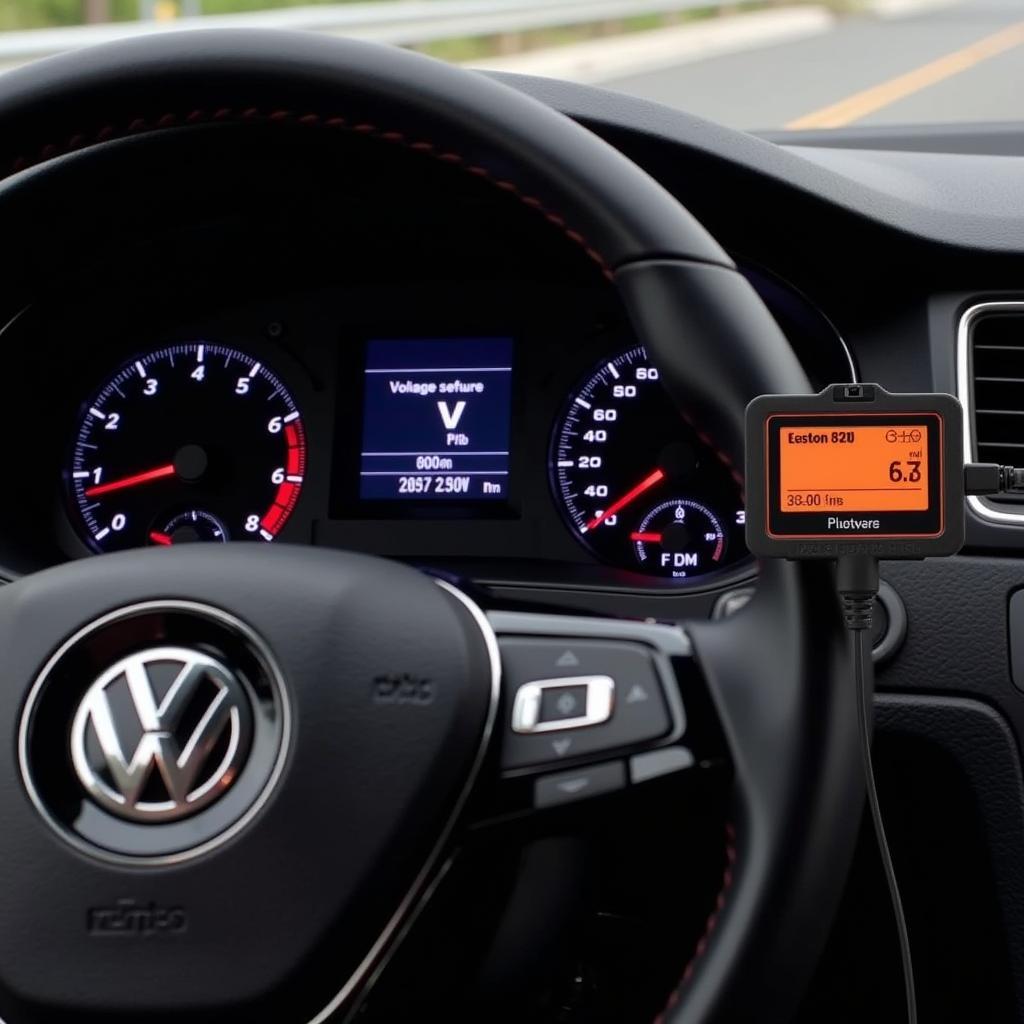Your cart is currently empty!

VCDS VW Voltage Check: A Comprehensive Guide
Using VCDS to check voltage in your Volkswagen is crucial for diagnosing electrical issues. This guide explores the importance of voltage checks, how to perform them with VCDS, and common problems you might encounter. Learn how this powerful tool can help you pinpoint and resolve electrical gremlins in your VW.
 VCDS VW Voltage Check on Dashboard Display
VCDS VW Voltage Check on Dashboard Display
Proper voltage is essential for the smooth operation of any vehicle, especially modern VWs packed with electronics. A VCDS VW voltage check helps diagnose problems ranging from a failing battery to more complex issues with sensors and control modules. Knowing how to use VCDS for this task can save you time and money. You can find more about VW specifics using vcds battery voltage.
Why Perform a VCDS VW Voltage Check?
A simple voltage check can reveal a wealth of information about your VW’s electrical system. It’s often the first step in diagnosing starting problems, dimming lights, or erratic behavior of electronic components.
- Identify a Dying Battery: A low voltage reading can indicate a weak or failing battery, a common cause of starting problems.
- Diagnose Charging System Issues: Voltage fluctuations or consistently low voltage while the engine is running can point to a problem with the alternator or voltage regulator.
- Troubleshooting Electrical Gremlins: Unusual voltage readings in specific circuits can help pinpoint faulty sensors, wiring harnesses, or control modules.
How to Perform a VCDS VW Voltage Check
Performing a VCDS VW voltage check is straightforward. Follow these steps:
- Connect VCDS to Your VW’s OBD-II Port: Ensure the ignition is switched on.
- Open VCDS Software: Select the correct model and control module.
- Navigate to Measuring Blocks: This is where you’ll find live data from various sensors.
- Select the Relevant Measuring Block: Look for the block that displays battery voltage or the specific circuit you’re interested in.
A healthy battery should read around 12.6 volts with the engine off and between 13.8 and 14.4 volts with the engine running. Deviations from these values warrant further investigation. Check out vw gear position vcds for another useful VCDS application.
Common Voltage-Related Issues in VWs
- Low Battery Voltage: This can be caused by a failing battery, parasitic drain, or a charging system problem.
- Overcharging: A faulty voltage regulator can lead to overcharging, which can damage the battery and other electrical components.
- Voltage Fluctuations: This can indicate a loose connection, corroded terminals, or a failing alternator.
How Can I Tell if My Alternator is Bad with VCDS?
One key indicator of a bad alternator is consistently low voltage while the engine is running. If the voltage doesn’t increase to the expected range after starting the engine, the alternator likely isn’t charging the battery correctly.
What are the Symptoms of a Bad Voltage Regulator?
Symptoms of a bad voltage regulator can include overcharging, undercharging, flickering lights, and even damage to electronic components due to voltage spikes. Using VCDS to monitor voltage can help diagnose these issues. Explore vcds showcase for more information about VCDS functionalities.
“Regularly checking your VW’s voltage with VCDS is like taking its pulse. It provides valuable insight into the health of the electrical system,” says automotive electronics expert, Dr. Thomas Mueller.
Troubleshooting VCDS Voltage Check Issues
Sometimes, you may encounter issues with the VCDS voltage check itself. Here’s what to do:
- Check Connections: Ensure the VCDS cable is firmly connected to both the OBD-II port and your computer.
- Update VCDS Software: Using the latest version ensures compatibility and access to the most up-to-date features. If you’re dealing with SRI reset issues, see vcds sri reset not working.
- Consult Online Forums: The VCDS community is vast and helpful; online forums can be a great resource for troubleshooting.
“VCDS empowers VW owners to take control of their vehicle’s diagnostics. It’s a valuable tool for anyone who wants to understand and maintain their VW,” adds Dr. Mueller. For information on DPF regeneration, visit vw dpf regen vcds.
Conclusion
Performing a VCDS VW voltage check is a simple yet powerful way to diagnose a wide range of electrical issues. Understanding how to use this tool can save you time and money in the long run. Regular voltage checks with VCDS can help you identify potential problems early, preventing costly repairs down the road. For further assistance or inquiries, don’t hesitate to connect with us. Contact vcdstool at +1 (641) 206-8880 and our email address: vcdstool@gmail.com. Our office is located at 6719 W 70th Ave, Arvada, CO 80003, USA.
by
Tags:
Leave a Reply